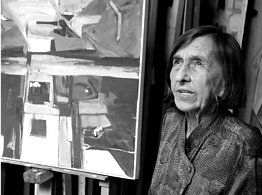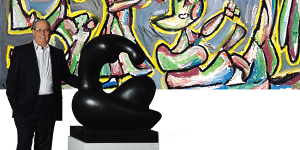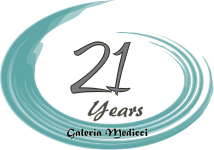Although since 1959 Luisa Richter regularly exhibits in museums and galleries in Caracas, in her workshop one can appreciate many of her works, especially those dating from the seventies. Not that her work lacks circulation among collectors, but, rather, her creative process is very intense. Not to make a statement, but is that on daily basis, exclusively, Luisa Richter is dedicated to the business of artistic creation.
Hence, when considering a new exhibition of the artist, both her recent production of 1997 - 1998, and the works of previous years, including the ones from the seventies and eighties must be taken into account, as a selection.
Seeing again the paintings of Luisa Richter implies experiencing the certainty of approaching a visual language. Hers is not known for facilitating popular access codes. Hers remains between planes and reflections, between crossings and connections, between moments and components, emptiness and fullness, between memory and metaphor, between the canvas and the paper, in short, on the stages of visibility.
In her painting, Richter works textures, transparency and planes of a spatial geometry. The subject of her painting is the space and its escape. Geometry in space without time or a center, in which sometimes brief figurative data happens among planes, reflections and the continuing constructive sense. Escape from the depths of space or the layout of the lines. Escape by the use of the checkerboard and visual changes it generates. But this has been temporary in her work as space remains, and is the centerpiece of her doing. The escape then inverts in the idea of the temporary Parallel to her paintings we have her works on paper, these collages based on old prints, drawing, writing and painting, where the artist displays the multiple value of the signs, a potential of lines - (paper, brush, ink ) - that test a grammar of space - time.
The diagonals are very important and constitute alternative visual transits to straight lines, to lintels, to the frame that appears and reappears. Master Ivan Petrovszky has commented on her line that has "character, always straight, never undulatory and generally with great sobriety." Linked lines and contrasted.
At one time the critics spoke of expressionism, referring to Richter's painting, just as her palette was of broader color registration. Then in the eighties, blue accents predominated in her painting. They were enclosed spaces, in perspectives, in diamonds that reflect obliquity and vice versa, with unfinished or open circles and squares, with a color after color, with thick lines that structure the fragments of the thing built, with a richness of color that moved. Gradually, the textures, the dynamics of the matter and the aggressiveness of the image.
After would come not only a change of color but also the resource of the line, often thick in the foreground, as refunding what happened in the work. Ring of grays and white fields to sign a melancholy of the painter, of what constitutes a permanent vision.
When we see her oil painting "Land Cut", 1959, we find several signals from all her doing: the light coming from the background of the work, the energetic brush lines that frame the space, a color between gray, blue and black and even her signature in print. The affinity with "Outlines", 1974, is amazing. The links with "The House of Oblivion", 1984, reveal the consistency of visual thinking. The phrasing "Tacarigua, 1988, restrained in its formulation, is proper of a vision that stands in the middle of its renovation. I've heard Petrovszky saying this phrase defining Richter’s painting: "It has the colors of chamber music because with few instruments it reaches the tonal purity."
Roberto Guevara referred in 1980, to Richter’s canvases as the "place of verification, that of individual truth, that of the image as an experience of reality. Also Guevara stated "the dual field of the times” involved in this work, so we also understand the dual space of sight between the interior condition of the being and eternal data of the circumstances.
Luisa Richter makes this double level from white, white tones to achieve the gray or atmospheric blues and cross through the remains of ocher. Strong and thick white lines, whites that pass from one to another plane. Line and color in a process of expansion or concentration, of moments and perimeters. “Flat Space " was the title of a series of her oil paintings shown in Venice in 1978. White, Cirlot says, "is somewhat more than a color" and then attributes the value to symbolize wholeness and synthesis of the different. "White, then, as the single element it is, at the same time, atmosphere, matter, line, gesture and sign. White is the reaffirmation of the sensible image.
All of the above to return to the main point by which the work is matter and form. For Richter, her expressive forms are not only traditional squares and rectangles, but even small ovals, long rectangles and large or reduced formats. Moreover, she not only integrates canvas and paper, but even takes fragments of her works - which for some reason did not interest her in its entirety - to reintegrate them into new creations. Her sense of collage, in conclusion, not only happens in her works on paper but also in her paintings.
The matter remains conditioned by the cumulative, albeit since prevailing the process based on white and gray, its space, its sign, its spelling, it is made behind the light, it goes on behind its architecture "between the light and the things" - she would say. Light in his case, as Maria Elena Ramos warned in 1988, behaves "as a maker of the flow, of the unfinished".
Over the years, Richter's work is characterized by a synthesis of language, a persistence of the existential question; engage in a visual that is based on the transmutation. Her work is the result of internalization and her call is produced in the enigma that could reflect us. "Painting, as the artist says, brings a new surprise each moment."
March 1999

Born in Besigheim, Germany in 1928 ,she has lived in Venezuela since 1955.
Solo Exhibits- Selection since 1981
1981 - Museum of Contemporary Art - Caracas, Venezuela
1981 - Gallery Ruchti - Cologne, Germany
1982 - Gallery Durban - Caracas, Venezuela
1982 - Viva Mexico Gallery - Caracas, Venezuela
1983 - Gallery Roosenhaus - Hamburg, Germany
1983 - Seven Seven Gallery - Caracas, Venezuela
1984 - Felix Gallery - Caracas, Venezuela
1984 – Venezuelan-Colombian Culture Center - Bogotá, Colombia
1984 - Museum of Contemporary Art - Montevideo, Uruguay
1985 - Cultural Center San Martín - Buenos Aires, Argentina
1985 - Gallery Roosenhaus - Hamburg, Germany
1985 - Euro-American Arts Center - Caracas, Venezuela
1985 - Ateneo of Caracas - Caracas, Venezuela
1987 – Hoy Art Gallery - Caracas, Venezuela
1988 - Gallery Durban - Caracas, Venezuela
1989 - Peter Fischinger Gallery - Stuttgart, Germany
1989 - Gala Gallery - Valencia, Venezuela
1990 - Gallery Astrid Paredes - Caracas, Venezuela
1991 - Gallery Durban - Caracas, Venezuela
1992 - Peter Fischinger Gallery - Stuttgart, Germany
1993 - Gallery Durban - Caracas, Venezuela
1994 - Graphic Arts Center - Caracas, Venezuela
1994 - Universidad de Los Andes - Mérida, Venezuela
1994 – Mendoza Hall - Caracas, Venezuela
1994 - Marina Square Gallery - Madrid, Spain
1995 - Colombia's Cultural Hall - Caracas, Venezuela
1995 - Gallery Angelika Harth - Stuttgart, Germany
1996 - Kunstverein, Springhornhof Neuenkirchen, in der Heide Lüneburg, Germany
1997 – Museum of Fine Arts - Caracas, Venezuela
1998 – Deutsche Welle / Potsdam - Berlin, Germany
1998 - Museum Sindelfingen - Stuttgart, Germany
1998 - Deutsche Welle - Cologne
1999 - Medicci Gallery - Caracas, Venezuela
2000 - University of Carabobo - Valencia, Carabobo, Venezuela
Awards and Honors
1952 - Württemberg Award for Youth, Stuttgart, Germany
1959 - Jose Loreto Arismendi Award at the XX Annual Official Show of Venezuelan Art, Museum of Fine Arts, Caracas, Venezuela
1960 – Prize for Drawing and Prints Universidad Central de Venezuela, Faculty of Architecture, Caracas, Venezuela
1963 - Emil Friedman Prize for Drawing, XXIV Annual Official Exhibit of Venezuela Art Museum of Fine Arts, Caracas, Venezuela
1966 - Award for prints and drawings of the Central University Venezuela, Faculty of Architecture, Caracas, Venezuela
1967 - National Design Award and Engraving, XXVIII Annual Official Show of Venezuelan Art, Museum of Fine Arts, Caracas, Venezuela
1982 - National Prize of Plastic Arts, Caracas, Venezuela
1993 - Award Andrés Bello, Bogotá, Colombia
2000 - First Prize, Second Biennial of Graphic Arts, Museum of Prints and Design "Carlos Cruz Diez, Caracas, Venezuela
Represented at
UNESCO, New York, NY, USA * UNESCO, Caracas, Venezuela
Branif Collection, University of Texas, Texas, USA
National Gallery, Stuttgart, Germany
City Gallery, Stuttgart, Germany
Museum of Visual Arts, Montevideo, Uruguay
Museum of Contemporary Art, Bogotá, Colombia
Bolivarian Museum, Santa Marta, Colombia
Museum of Modern Art, Rio de Janeiro, Brazil
Museum of Latin American Prints, San Juan, Puerto Rico
Embassy of Venezuela in Rome-Madrid-Brussels-Paris-Havana-Bogotá
Colombian Venezuelan of Culture, Bogotá, Colombia
Forum Gallery, Lima, Peru * Consolidated Bank, Caracas, Venezuela
Collection of the Chancellery of Surinam, Dutch Guiana
Museum of Contemporary Art of Caracas Sofia Imber, Caracas, Venezuela
Museum of Fine Arts, Caracas, Venezuela
Museum of Modern Art, Merida, Venezuela
Museum of Ciudad Bolivar, Ciudad Bolivar, Venezuela
Ministry of Foreign Affairs, Caracas, Venezuela
National Art Gallery, Caracas, Venezuela
Museum Alejandro Otero, Caracas, Venezuela
CONAC, Caracas, Venezuela * Ateneo of Caracas, Caracas, Venezuela
Universidad Central de Venezuela, Caracas, Venezuela
Universidad Simón Bolívar, Caracas, Venezuela
Universidad del Zulia, Maracaibo, Venezuela
Mission of Venezuela at the European Community, Brussels, Belgium

Interview with Mr. Tomás Kepets, director of the Medicci Gallery
Read more
"During those two decades, Galeria Medicci advanced into a river of creations and continues to show the majors artists, the vanguard of every moment, lucidity and everything that bridges with spiritual values. The experiences accumulated in more than two decades have sharpened the dynamics of today ". José Pulido
Works of renowned artists in the United States, the Caribbean and Latin America such as Manuel Mendive, Carlos Luna and the American sculptor Manuel Carbonell, as well as Venezuelan expats based in Paris, France, Annette Turrillo and Karim Borjas.